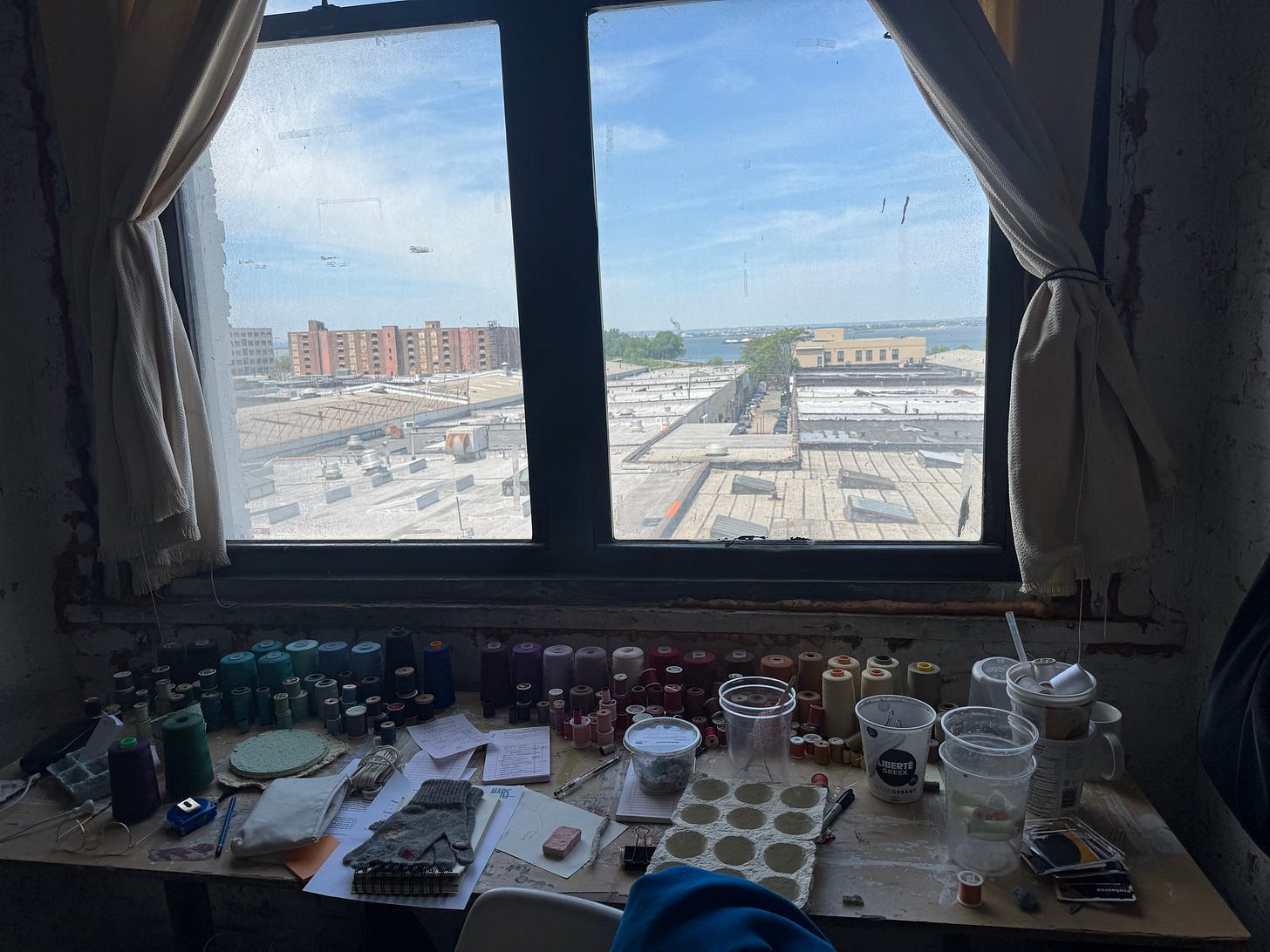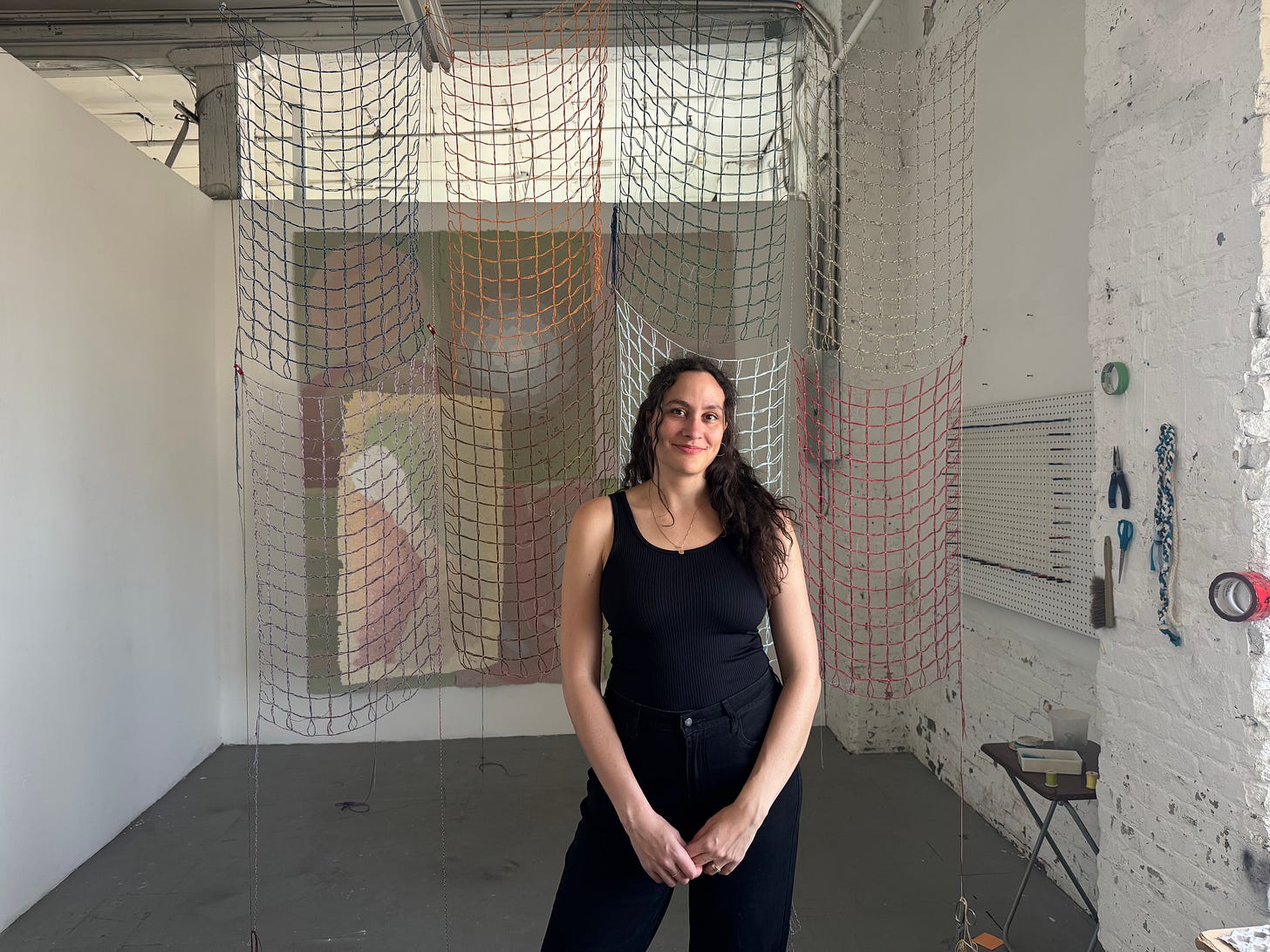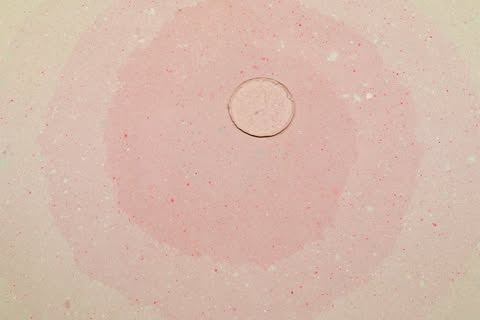The Artist Who Turns Trash into Tenderness
In a studio filled with sun, thread, and quiet defiance, Canadian artist Camille reclaims what’s been discarded, turning textile waste and handmade paper into meditative, impermanent works of art.
New York is full of surprises, but my favorite is that you’re always meeting people who open doors you didn’t know existed.
That’s how I met Camille Lescarbeau, through MC Duval, an artist whose work radiates just as much depth and clarity as she does in person.
MC and I met years ago and became fast friends. She’s one of those women whose creativity is matched by quiet generosity, always connecting, always uplifting.
Her own career is remarkable: she’s received top awards in national exhibitions, including First Prize in Painting from Lisa Dennison of the Guggenheim, a Director's Prize from Maxwell Anderson of the Whitney, and a Print Prize from Sotheby’s. Her work has been exhibited across the U.S. and Europe and is part of the National Museum of Women in the Arts archives.
One afternoon, Duval invited me to a casual brunch where I first met Camille. A few weeks later, I found myself in Camille’s studio at the NARS Foundation, standing beneath handwoven nets made from reclaimed threads, surrounded by light, care, and stories waiting to unfold.
This is Camille’s world, where waste becomes wonder, and craft becomes a quiet act of resistance.
Let’s be real, craft has been sidelined in contemporary art conversations for years. It’s too feminine, too fragile, too… slow. But in Camille’s Brooklyn studio, slowness is a strategy. And imperfection? That’s where the poetry lives.
We met one afternoon in her studio, where the light fell in soft stripes through tall windows. There were delicate grids made from twisted thread, suspended like woven thoughts. On the desk: spools of color, scraps of failed attempts, a cup of yogurt rinsed and reused to store pulp. It smelled faintly of paper, of something handmade and old.
Camille is a Canadian artist and current resident at the NARS Foundation, where she’s doing something bold in its simplicity: turning waste into wonder. Think recycled textiles, inherited sewing kits, and handmade paper, all transformed into soft structures that ask us to slow down and feel.
And no, this isn’t another “trash into treasure” feel-good story. This is systems thinking. It’s hands-on activism disguised as tenderness.
“Papermaking feels like a marathon, physical, meditative, and relentless. I go through awe, frustration, and joy. It feels like everything.”
Camille comes from a dance background, which makes sense when you see her repetitive, bodily, rhythmic process. Her papermaking method isn’t delicate; it’s demanding. Once she starts, there’s no pause button. One piece can take 14 hours. She’s not just creating paper, she’s committing to it.
“Once I discovered papermaking,” she tells me, “I understood why I’d been saving scraps. They were waiting for something.”
That “something” is a visual language rooted in care, memory, and material integrity.
Waste isn’t waste until we waste it.
Camille doesn’t just reuse materials, she listens to them. Old textiles from family homes, discarded drawings from artist friends, yarns rescued from studio bins. Each scrap holds a memory. Each piece asks for time.
“Some materials are so dear, I use them slowly,” she says. “Piece by piece, breath by breath.”
This isn’t nostalgia. It’s intentionality. Camille’s practice is what happens when sustainability stops being a buzzword and starts being a worldview.
Sloppy Craft = Soft Resistance
In a world that celebrates machine-made perfection, Camille leans toward something looser. Her work draws from the Sloppy Craft movement, which rejects clean lines, polished surfaces, and invisible labor.
And it’s not just an aesthetic choice. It’s political.
“Being radically sustainable forced me to embrace imperfection,” she explains. “It’s about letting go of control and trusting the process.”
Camille isn’t trying to hide the seams. She’s highlighting them because that’s where Care lives.
Beyond the Object: Craft as Infrastructure
Right now, at NARS, she’s developing a textile installation using sewing kits passed down from women in her family and community. Tools once used to mend clothes, patch knees, and stitch love into everyday life. Tools full of fingerprints, ghosts, and domestic genius.
She’s not just preserving these histories, she’s reanimating them.
“The knowledge wasn’t passed down, but the tools were,” Camille says. “So I’m teaching myself through them.”
This is repair culture at its most poetic. It’s what happens when sustainability meets intimacy.
“Permanence is an arrogance. I don’t want to make timeless work, I want to make honest work.”
Camille’s pieces are designed to disappear. Her handmade paper breaks down. Her threads fray. The work lives, then returns to the earth.
And that’s the point.
“I’m not here to make art that outlives me,” she says. “I’m here to treat the materials like guests.”
That humility, that reframing of authorship,is what sets Camille apart.
If this is the future of craft, we’re in good hands.
Camille’s work isn’t loud. It doesn’t clamor for attention. But it stays with you. Like a thread caught on your sleeve. Like something soft you almost threw away—and were lucky enough to find again.
So what can we learn from her?
That slowness is a superpower.
That care is a form of resistance.
That even our trash still has stories to tell.
There was something in Camille’s studio that felt deeply familiar. My own grandmother used a large loom to weave all the carpets and velințe, traditional Romanian wool blankets, by hand. My grandfather was a shepherd, and I remember sitting beside my grandmother, spinning wool and watching her knit the clothes we wore through winter.
Being in Camille’s space brought those memories back with quiet force. Her work, like my grandmother’s, carries a lineage of care through the hands. A rhythm, a reverence, and the gentle power of making something lasting from what’s often overlooked.
Vera
I really hope you're enjoying The Sustainability Pulse, my weekly newsletter looking at sustainability in the fashion industry. If you enjoyed this story, consider subscribing to Sustainability Pulse, a space where craft, care, and climate meet.







